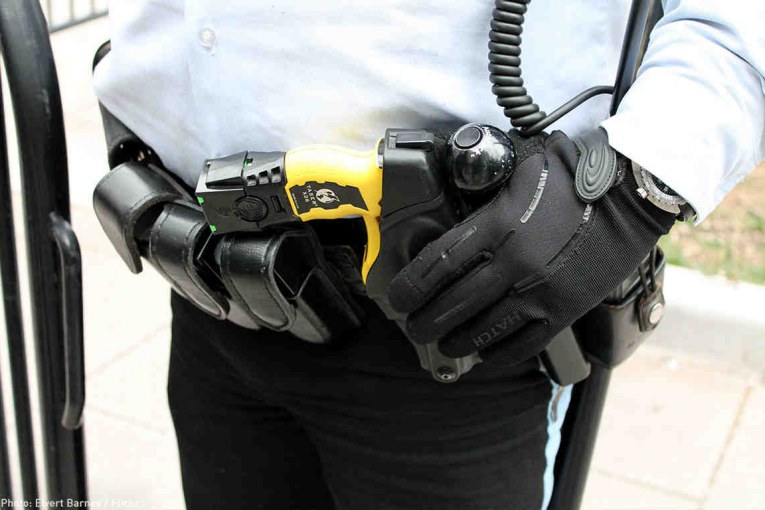
OAKLAND, CA – An East Bay Park District police officer left a San Fransisco man in a comatose state after repeatedly tasing the man standing in cold salt water, and then watching him struggle for half an hour, charged J. Davis Law Firm, PLLC, and Pointer & Buelna, LLP Lawyers for The People.
The lawyers Tuesday claimed, in a federal civil rights lawsuit, “The police officer repeatedly tased him and left him struggling in 50-degree water until his lungs filled. The officers did not call for EMT or paramedic services until after the man was nonresponsive and pulled from the water nearly 40 minutes after being tased.”
Deontae Faison, 35, remains unresponsive since the April 5, 2024, incident occurred at Martin Luther King, Jr., Regional Shoreline Park, the lawyers added.
“Officers are trained to avoid tasing people while they are in water in order to avoid this very same tragic, yet preventable, result. Deontae, a father of two, was left in a coma due to the officer’s overly aggressive and potentially fatal conduct,” explained civil rights attorney Adanté Pointer, of Oakland-based Pointer & Buelna.
Pointer added that “the repeated use of a taser, particularly in water, was not only excessive but reckless — violating the very standards set by not only the taser manufacturer but the district’s policies to protect lives.”
Civil rights attorney Jamir Davis, of J. Davis Law Firm, PLLC, said, “Deontae’s family will not rest until these officers are held accountable. The level of disregard and callousness the officers showed as they comfortably stood by and watched Deontae call out for help while flailing his arms in a desperate bid to avoid drowning is unforgivable.
“Deontae and a friend were enjoying a picnic at the park on a warm afternoon when a passing park police officer approached them with his vehicle’s emergency lights on. The officer accused Deontae of driving a vehicle with expired tags and ordered them to sit on the bumper of a van.”
According to the lawsuit, “Deontae, who is Black, became nervous and upset because the officer was treating him differently than his friend, who is white. Deontae gave the officer an alias, and the officer told him he would bring in a fingerprinting tech when his name didn’t come up. The officer never asked the friend if she was the van’s driver, did not initially run her name through the criminal database, nor did he threaten to bring a fingerprint tech to the scene when he could not locate her name.”
The lawyers’ statement added, Faison started to panic as more officers arrived on scene. The park police officer, from the original interaction, pulled out his service weapon, causing the unarmed Faison to run toward the estuary.
As Faison started to run the officer shot him in the back with his taser, the suit claims, adding Faison at first collapsed on the beach but then continued to the water as the officer repeatedly tased him through the darts stuck to his back.
The complaint added, “Deontae struggled in the water for over 30 minutes, calling for help, according to the officer’s own report. Only after he became unconscious and floated closer to shore did officers pull him out.
“Officers then watched Deontae gasp for air on the bank of the estuary for nearly 15 minutes and did not render any lifesaving aid. Deontae then became unresponsive and was brought to Alameda Hospital where he was resuscitated. He has been in a coma ever since.”
The lawyers added, “Tasing someone who is wet or in water is against district policy, the lawsuit states. The manufacturer also cautions against using the device in water. Taser shocks are intended to cause pain and loss of muscle control, and are known to elevate heart rate and disrupt breathing. Water increases the spread and depth of the electric shocks. And tasing someone in salt water is especially dangerous because salt is especially conductive.”
None of the officers had called for an EMT or paramedic services until after Faison was retrieved from the water, and the officer never told the paramedics Faison was tased.
“The lawsuit accuses the officer of purposefully concealing evidence by instructing officers to turn off their body-worn camera sound, disposing of Deontae’s clothing and taser strings, and failing to take witness statements from Deontae’s friend,” the lawsuit reads.
In addition to concealing evidence, according to the lawyers’ statement, “The officers also drafted fraudulent reports claiming they believed Deontae was armed.”
“Deontae was subjected to a level of force and scrutiny that his white friend was spared, simply because of the color of his skin,” Pointer said.
“The officers’ deliberate indifference to Deontae’s life is appalling. They stood there for over half an hour watching him struggle for his life. Their failure to render aid, compounded by efforts to destroy evidence and draft fraudulent reports, shows a blatant disregard for justice and human life.”